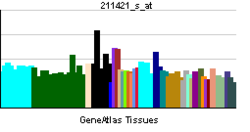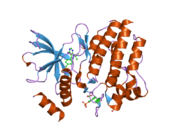RET proto-onkogen
| edit |
| Ret proto-onkogen[1] | |||||||||||
|---|---|---|---|---|---|---|---|---|---|---|---|
| Dostupne strukture | |||||||||||
| 1XPD, 2IVS, 2IVT, 2IVU, 2IVV, 2X2K, 2X2L, 2X2M, 2X2U, 4CKI, 4CKJ | |||||||||||
| Identifikatori | |||||||||||
| Simboli | RET; CDHF12; CDHR16; HSCR1; MEN2A; MEN2B; MTC1; PTC; RET-ELE1; RET51 | ||||||||||
| Vanjski ID | OMIM: 164761 MGI: 97902 HomoloGene: 7517 GeneCards: RET Gene | ||||||||||
| EC broj | 2.7.10.1 | ||||||||||
| |||||||||||
| Pregled RNK izražavanja | |||||||||||
 | |||||||||||
 | |||||||||||
 | |||||||||||
| podaci | |||||||||||
| Ortolozi | |||||||||||
| Vrsta | Čovek | Miš | |||||||||
| Entrez | 5979 | 19713 | |||||||||
| Ensembl | ENSG00000165731 | ENSMUSG00000030110 | |||||||||
| UniProt | P07949 | P35546 | |||||||||
| Ref. Sekv. (iRNK) | NM_000323 | NM_001080780 | |||||||||
| Ref. Sekv. (protein) | NP_065681 | NP_001074249 | |||||||||
| Lokacija (UCSC) | Chr 10: 43.57 - 43.63 Mb | Chr 6: 118.15 - 118.2 Mb | |||||||||
| PubMed pretraga | [1] | [2] | |||||||||
RET proto-onkogen kodira receptorsku tirozinsku kinazu za koju se vezuju članovi familije ekstracelularnih signalnih molekula, neurotrofnih faktora (GDNF) izvedeni iz glijalnih ćelija.[2] RET mutacije sa gubutkom funkcije su asocirane sa razvojem Hirschsprung bolesti, dok su mutacije sa sticanjem funkcije praćene razvojem raznih tipova ljudskih kancera, uključujući medularni tiroidni karcinom, multiple endokrine neoplazije tipa 2A i 2B, feohromocitom i paratiroidnu hiperplaziju.
RET proto-onkogen formira interakcije sa GRB10,[3] STAT3,[4][5][6] DOK5,[7][8] Grb2,[3][9] GRB7,[10] DOK1,[11] SHC1[9][12] i GDNF familijom receptora alfa 1.[13][14]
- ↑ PDB 2ivs; Knowles PP, Murray-Rust J, Kjaer S, Scott RP, Hanrahan S, Santoro M, Ibáñez CF, McDonald NQ (November 2006). „Structure and chemical inhibition of the RET tyrosine kinase domain”. J. Biol. Chem. 281 (44): 33577–87. DOI:10.1074/jbc.M605604200. PMID 16928683.
- ↑ Knowles PP, Murray-Rust J., and others (2006). „Structure and chemical inhibition of the RET tyrosine kinase domain”. J. Biol. Chem. 281 (44): 33577–87. DOI:10.1074/jbc.M605604200. PMID 16928683.
- ↑ 3,0 3,1 Pandey, A; Duan H; Di Fiore P P; Dixit V M (September 1995). „The Ret receptor protein tyrosine kinase associates with the SH2-containing adapter protein Grb10”. J. Biol. Chem. (UNITED STATES) 270 (37): 21461–3. DOI:10.1074/jbc.270.37.21461. ISSN 0021-9258. PMID 7665556.
- ↑ Yuan, Zheng-Long; Guan Ying-Jie; Wang Lijuan; Wei Wenyi; Kane Agnes B; Chin Y Eugene (November 2004). „Central role of the threonine residue within the p+1 loop of receptor tyrosine kinase in STAT3 constitutive phosphorylation in metastatic cancer cells”. Mol. Cell. Biol. (United States) 24 (21): 9390–400. DOI:10.1128/MCB.24.21.9390-9400.2004. ISSN 0270-7306. PMC 522220. PMID 15485908.
- ↑ Hwang, Jung Hwan; Kim Dong Wook, Suh Jae Mi, Kim Ho, Song Jung Hun, Hwang Eun Suk, Park Ki Cheol, Chung Hyo Kyun, Kim Jin Man, Lee Tae-Hoon, Yu Dae-Yeul, Shong Minho (June 2003). „Activation of signal transducer and activator of transcription 3 by oncogenic RET/PTC (rearranged in transformation/papillary thyroid carcinoma) tyrosine kinase: roles in specific gene regulation and cellular transformation”. Mol. Endocrinol. (United States) 17 (6): 1155–66. DOI:10.1210/me.2002-0401. ISSN 0888-8809. PMID 12637586.
- ↑ Schuringa, J J; Wojtachnio K; Hagens W; Vellenga E; Buys C H; Hofstra R; Kruijer W (August 2001). „MEN2A-RET-induced cellular transformation by activation of STAT3”. Oncogene (England) 20 (38): 5350–8. DOI:10.1038/sj.onc.1204715. ISSN 0950-9232. PMID 11536047.
- ↑ Crowder, Robert J; Enomoto Hideki; Yang Mao; Johnson Eugene M; Milbrandt Jeffrey (October 2004). „Dok-6, a Novel p62 Dok family member, promotes Ret-mediated neurite outgrowth”. J. Biol. Chem. (United States) 279 (40): 42072–81. DOI:10.1074/jbc.M403726200. ISSN 0021-9258. PMID 15286081.
- ↑ Grimm, J; Sachs M, Britsch S, Di Cesare S, Schwarz-Romond T, Alitalo K, Birchmeier W (July 2001). „Novel p62dok family members, dok-4 and dok-5, are substrates of the c-Ret receptor tyrosine kinase and mediate neuronal differentiation”. J. Cell Biol. (United States) 154 (2): 345–54. DOI:10.1083/jcb.200102032. ISSN 0021-9525. PMC 2150770. PMID 11470823.
- ↑ 9,0 9,1 Borrello, M G; Pelicci G; Arighi E; De Filippis L; Greco A; Bongarzone I; Rizzetti M; Pelicci P G i dr.. (June 1994). „The oncogenic versions of the Ret and Trk tyrosine kinases bind Shc and Grb2 adaptor proteins”. Oncogene (ENGLAND) 9 (6): 1661–8. ISSN 0950-9232. PMID 8183561.
- ↑ Pandey, A; Liu X; Dixon J E; Di Fiore P P; Dixit V M (May 1996). „Direct association between the Ret receptor tyrosine kinase and the Src homology 2-containing adapter protein Grb7”. J. Biol. Chem. (UNITED STATES) 271 (18): 10607–10. DOI:10.1074/jbc.271.18.10607. ISSN 0021-9258. PMID 8631863.
- ↑ Murakami, Hideki; Yamamura Yumiko; Shimono Yohei; Kawai Kumi; Kurokawa Kei; Takahashi Masahide (September 2002). „Role of Dok1 in cell signaling mediated by RET tyrosine kinase”. J. Biol. Chem. (United States) 277 (36): 32781–90. DOI:10.1074/jbc.M202336200. ISSN 0021-9258. PMID 12087092.
- ↑ Arighi, E; Alberti L, Torriti F, Ghizzoni S, Rizzetti M G, Pelicci G, Pasini B, Bongarzone I, Piutti C, Pierotti M A, Borrello M G (February 1997). „Identification of Shc docking site on Ret tyrosine kinase”. Oncogene (ENGLAND) 14 (7): 773–82. DOI:10.1038/sj.onc.1200896. ISSN 0950-9232. PMID 9047384.
- ↑ Klein, R D; Sherman D, Ho W H, Stone D, Bennett G L, Moffat B, Vandlen R, Simmons L, Gu Q, Hongo J A, Devaux B, Poulsen K, Armanini M, Nozaki C, Asai N, Goddard A, Phillips H, Henderson C E, Takahashi M, Rosenthal A (June 1997). „A GPI-linked protein that interacts with Ret to form a candidate neurturin receptor”. Nature (ENGLAND) 387 (6634): 717–21. DOI:10.1038/42722. ISSN 0028-0836. PMID 9192898.
- ↑ Cik, M; Masure S; Lesage A S; Van Der Linden I; Van Gompel P; Pangalos M N; Gordon R D; Leysen J E (September 2000). „Binding of GDNF and neurturin to human GDNF family receptor alpha 1 and 2. Influence of cRET and cooperative interactions”. J. Biol. Chem. (UNITED STATES) 275 (36): 27505–12. DOI:10.1074/jbc.M000306200. ISSN 0021-9258. PMID 10829012.
- Eng C, Mulligan LM (1997). „Mutations of the RET proto-oncogene in the multiple endocrine neoplasia type 2 syndromes, related sporadic tumours, and hirschsprung disease”. Hum. Mutat. 9 (2): 97–109. DOI:10.1002/(SICI)1098-1004(1997)9:2<97::AID-HUMU1>3.0.CO;2-M. PMID 9067749.
- Hofstra RM, Osinga J, Buys CH (1998). „Mutations in Hirschsprung disease: when does a mutation contribute to the phenotype”. Eur. J. Hum. Genet. 5 (4): 180–5. PMID 9359036.
- Nikiforov YE (2002). „RET/PTC rearrangement in thyroid tumors”. Endocr. Pathol. 13 (1): 3–16. DOI:10.1385/EP:13:1:03. PMID 12114746.
- Santoro M, Melillo RM, Carlomagno F, and others (2004). „Minireview: RET: normal and abnormal functions”. Endocrinology 145 (12): 5448–5451. DOI:10.1210/en.2004-0922. PMID 15331579.
- Santoro M, Carlomagno F, Melillo RM, Fusco A (2005). „Dysfunction of the RET receptor in human cancer”. Cell. Mol. Life Sci. 61 (23): 2954–2964. DOI:10.1007/s00018-004-4276-8. PMID 15583857.
- Niccoli-Sire P, Conte-Devolx B, (2005). „[RET mutations and preventive treatment of medullary thyroid cancer]”. Ann. Endocrinol. (Paris) 66 (3): 168–75. DOI:10.1016/s0003-4266(05)81748-2. PMID 15988377.
- Lantieri F, Griseri P, Ceccherini I (2006). „Molecular mechanisms of RET-induced Hirschsprung pathogenesis”. Ann. Med. 38 (1): 11–9. DOI:10.1080/07853890500442758. PMID 16448984.
- Ciampi R, Nikiforov YE (2007). „RET/PTC rearrangements and BRAF mutations in thyroid tumorigenesis”. Endocrinology 148 (3): 936–41. DOI:10.1210/en.2006-0921. PMID 16946010.
- Plaza-Menacho I, Burzynski GM, de Groot JW, and others (2007). „Current concepts in RET-related genetics, signaling and therapeutics”. Trends Genet. 22 (11): 627–36. DOI:10.1016/j.tig.2006.09.005. PMID 16979782.



